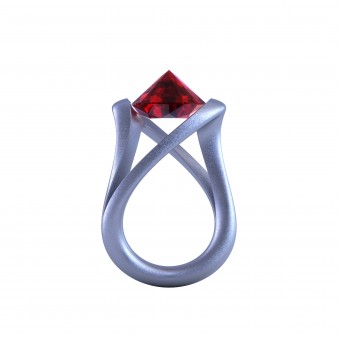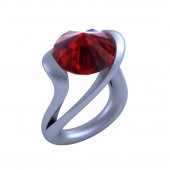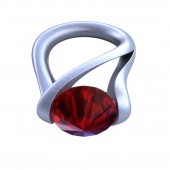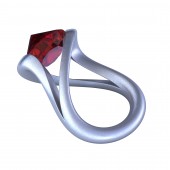DESIGN NAME:
Bypass tension
PRIMARY FUNCTION:
Ruby ring
INSPIRATION:
the inspiration of this design comes from an idea to make a new-fashion looking and contemporary ring with an special technique to hold the stone, Tension setting is one of the newest method of diamond setting which invented and making it like a bypass ring is a great goal, reducing the design elements and making a minimal looking design was the main target for this ring.
UNIQUE PROPERTIES / PROJECT DESCRIPTION:
This is a Ruby gemstone ring with a unique setting "Bypass tension" which holds the stone without any prongs or extra metal. The tension creates pressure onto the central Ruby gemstone and this is what holds the stone securely in place. The amazing 8.30 carat ruby putted vice versa to adds a contemporary modern look to the ring. The ruby can be set in the ring after small grooves are cut into the sides of the ring, so it appears to float in mid-air between the sides of the shank.
OPERATION / FLOW / INTERACTION:
A major difference between tension settings and other settings is that tension settings are only manufactured after they are sold while other settings are often manufactured first and then sold to consumers. There are several reasons for this difference. First, tension settings can not be resized easily as resizing them will remove the spring-loading effect. In cases they can be resized up or down up to 2 sizes but does depend on the design in question. A lot of the time instead of resizing a tension setting, the manufacturer actually has to melt down the old setting and create a new spring-loaded tension setting that is appropriately sized. Second, tension settings are calibrated to the exact specifications of the stone that they will hold, therefore they can not be manufactured until the customer has selected the gem that will go inside.
PROJECT DURATION AND LOCATION:
This project started in Feb 2014 in Tehran and finished in March 2014 in Tehran,
|
PRODUCTION / REALIZATION TECHNOLOGY:
18 K white gold
Songea Ruby 8.30 Carat
SPECIFICATIONS / TECHNICAL PROPERTIES:
Height : 36.00 mm
Width : 22.50 mm
Metal Weight : 10 grams
TAGS:
Ruby Ring-Diamond ring,Tension setting ring
RESEARCH ABSTRACT:
Because tension settings place such pressure on the stone, only four types of gemstone can be placed in a tension setting safely: diamonds, rubies, moissanite,and sapphires. Additionally, tension setting manufacturers must be careful which stones they place in tension settings; a stone that either has significant inclusions or is too soft will fracture under the intense pressure of the setting. The Mohs scale is a reliable way to rank a gem's hardness; generally gems that have a Mohs hardness of less than 9.0 cannot be placed in the setting.
It should also be noted that the term "tension setting" is, from the perspective of physical science, a misnomer. The stone is not held in tension (a pulling force) but in fact in compression (a pressing force).
CHALLENGE:
There are conflicting perspectives regarding the security of tension settings. Many jewelers contend that tension settings are as safe and potentially safer than four and six prong settings, but there are others who contend that prongs are stronger. The reality is that both ring designs have weaknesses that are unique to their engineering process. Prongs can snag on clothes and other loose objects, and they weaken with time and usage. As a result, prongs must be repaired or replaced periodically. On the other hand, tension settings will not lose their spring-loading over time, and the stone will therefore not fall out as a result of the setting weakening. Critics do contend that a stone can potentially be dislodged from a tension setting if it is hit hard enough or if the setting is damaged to the point where its spring loading is compromise
ADDED DATE:
2014-03-28 02:09:31
TEAM MEMBERS (1) :
IMAGE CREDITS:
Seyed Mohammad Mortazavi, 2013.
|









